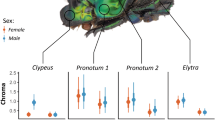Abstract
Morphological and behavioural traits can serve as anti-predator defence either by reducing detection or recognition risks, or by thwarting initiated attacks. The latter defence is secondary and often involves a ‘startle display’ comprising a sudden release of signals targeting more than one sensory modality. A suggested candidate for employing a multimodal defence is the peacock butterfly, Inachis io, which, by wing-flicking suddenly, produces sonic and ultrasonic sounds and displays four large eyespots when attacked. The eyespots make small birds retreat, but whether the sounds produced thwart predator attacks is largely unknown. Peacocks hibernate as adults in dark wintering sites and employ their secondary defence upon encounter with small rodent predators during this period. In this study, we staged predator–prey encounters in complete darkness in the laboratory between wild mice, Apodemus flavicollis and Apodemus sylvaticus, and peacocks which had their sound production intact or disabled. Results show that mice were more likely to flee from sound-producing butterflies than from butterflies which had their sound production disabled. Our study presents experimental evidence that the peacock butterfly truly employs a multimodal defence with different traits targeting different predator groups; the eyespots target birds and the sound production targets small rodent predators.

Similar content being viewed by others
References
Barber JR, Conner WE (2007) Acoustic mimicry in a predator-prey interaction. P Natl Acad Sci U S A 104:9331–9334
Blest AD (1957) The function of eyespot patterns in the Lepidoptera. Behaviour 11:209–255
Brakefield PM, Shreeve TG, Thomas JA (1992) Avoidance, concealment, and defence. In: Dennis RLH (ed) The ecology of butterflies in Britain. Oxford University Press, Oxford, pp 93–119
Bura VL, Fleming AJ, Yack JE (2009) What’s the buzz? Ultrasonic and sonic warning signals in caterpillars of the great peacock moth (Saturnia pyri). Naturwissenschaften 96:713–718
Corcoran AJ, Barber JR, Conner WE (2009) Tiger moth jams bat sonar. Science 325:325–327
Dvořák L, Belicek J, Fric Z (2002) Observations of overwintering nymphalid butterflies in underground shelters in SW and W Bohemia (Czech Republic) (Lepidoptera: Nymphalidae: Nymphalini). J Res Lepidoptera 41:45–52
Edmunds M (1974) Defence in animals: a survey of anti-predator defences. Longman Ltd., New York
Hagen SB, Leinaas HP, Lampe HM (2003) Responses of great tits Parus major to small tortoiseshells Aglais urticae in feeding trials; evidence of aposematism. Ecological Entomology 28:503–509
Kirchner WH, Roschard J (1999) Hissing in bumblebees: an interspecific defence signal. Insectes Soc 46:239–243
Larsen TB (1991) The butterflies of Kenya and their natural history. Oxford University Press, Oxford
Lind J, Cresswell W (2005) Determining the fitness consequences of antipredation behavior. Behav Ecol 16:945–956
Mohl B, Miller LA (1976) Ultrasonic clicks produced by peacock butterfly—possible bat-repellent mechanism. J Exp Biol 64:639–644
Olofsson M, Vallin A, Jakobsson S, Wiklund C (2011) Winter predation on two species of hibernating butterflies: monitoring rodent attacks with infrared cameras. Anim Behav 81:529–534
Pie MR (2005) Signal evolution in prey recognition systems. Behav Process 68:47–50
Ratcliffe JM, Nydam ML (2008) Multimodal warning signals for a multiple predator world. Nature 455:96–U59
Rowe C, Guilford T (1999) The evolution of multimodal warning displays. Evol Ecol 13:655–671
Ruxton GD (2005) Intimidating butterflies. Trends Ecol Evol 20:276–278
Ruxton GD, Sherratt TN, Speed MP (2004) Avoiding attack. Oxford University Press, Oxford
Scott JA (1986) The butterflies of North America: a natural history and field guide. Stanford University Press, Stanford
Siddall EC, Marples NM (2008) Better to be bimodal: the interaction of color and odor on learning and memory. Behav Ecol 19:425–432
Skelhorn J, Rowland HM, Speed MP, Ruxton GD (2010) Masquerade: camouflage without crypsis. Science 327:51
Thomas JA, Lewington R (2010) The butterflies of Britain and Ireland. British Wildlife Publishing Ltd, Dorset
Vallin A, Jakobsson S, Lind J, Wiklund C (2005) Prey survival by predator intimidation: an experimental study of peacock butterfly defence against blue tits. P R Soc B 272:1203–1207
Vallin A, Jakobsson S, Lind J, Wiklund C (2006) Crypsis versus intimidation—anti-predation defence in three closely related butterflies. Behav Ecol Sociobiol 59:455–459
Vane-Wright RI (1986) The snake hiss of hibernating peacocks—audioBatesian mimicry? Antenna 10:5–6
Wiklund C (2005) Hornet predation on peacock butterflies and ecological aspects on the evolution of complex eyespots on butterfly wings. Entomol Fennica 16:266–272
Wiklund C, Vallin A, Friberg M, Jakobsson S (2008) Rodent predation on hibernating peacock and small tortoiseshell butterflies. Behav Ecol Sociobiol 62:379–389
Acknowledgements
We thank M. Friberg for statistical advice and U. Kodandaramaiah, B. Tullberg and S. Andersson for valuable comments on the manuscript. We also thank L. Svensson for capture and husbandry of mice.
Author information
Authors and Affiliations
Corresponding author
Additional information
Communicated by D. Kemp
Electronic supplementary material
Below is the link to the electronic supplementary material.
(MPG 5.02 MB)
(MPG 5.47 MB)
Rights and permissions
About this article
Cite this article
Olofsson, M., Jakobsson, S. & Wiklund, C. Auditory defence in the peacock butterfly (Inachis io) against mice (Apodemus flavicollis and A. sylvaticus). Behav Ecol Sociobiol 66, 209–215 (2012). https://doi.org/10.1007/s00265-011-1268-1
Received:
Revised:
Accepted:
Published:
Issue Date:
DOI: https://doi.org/10.1007/s00265-011-1268-1




